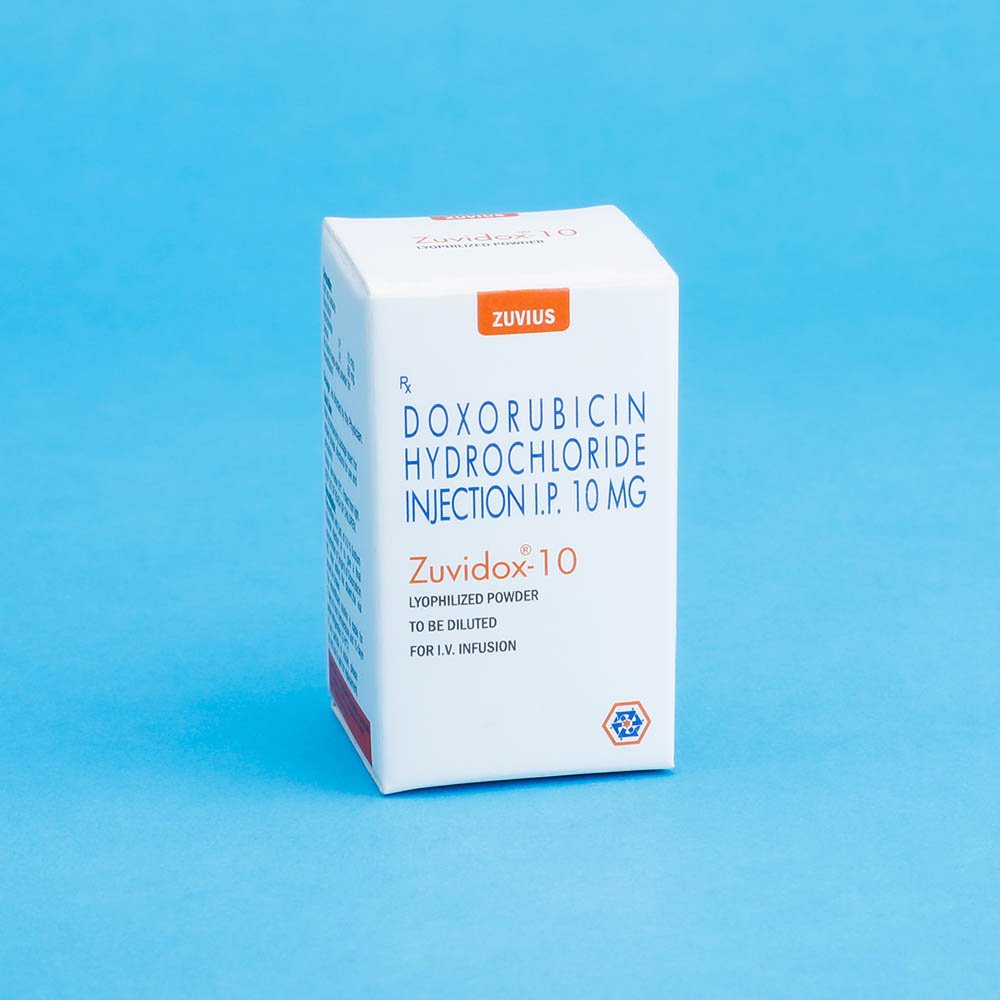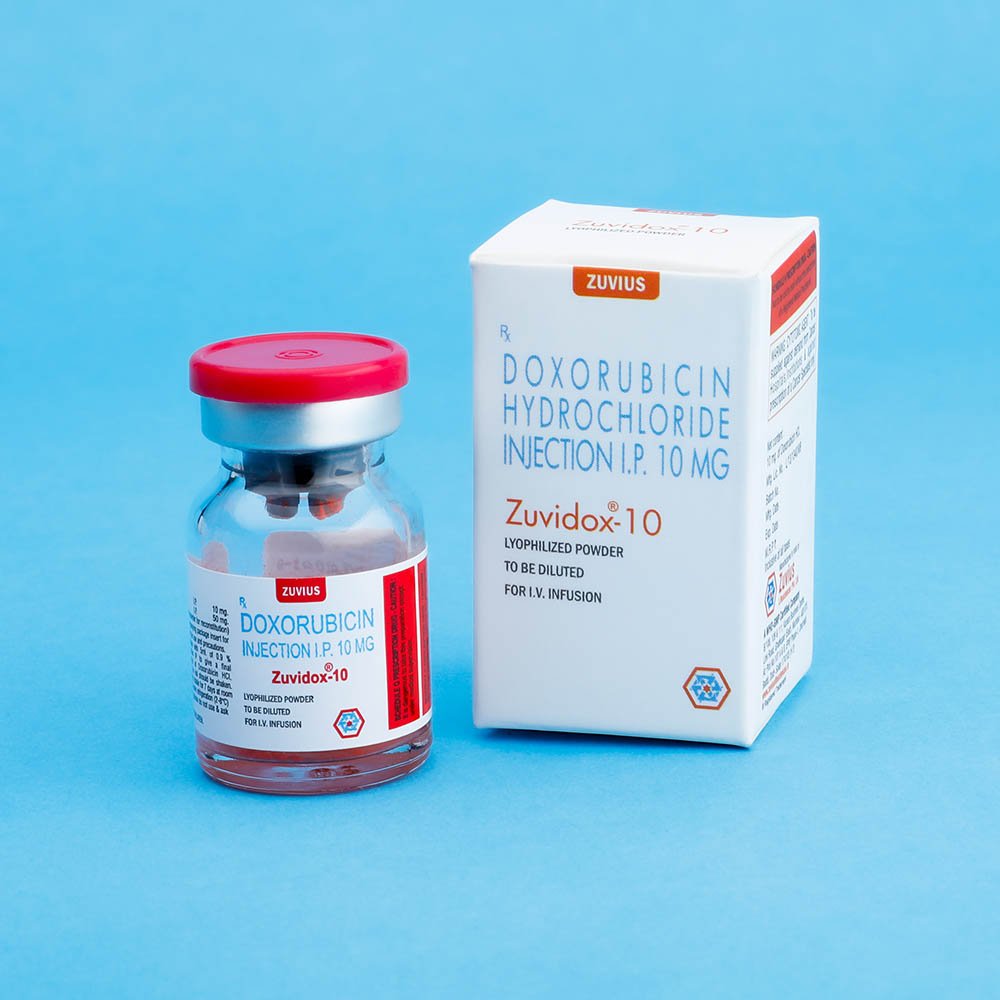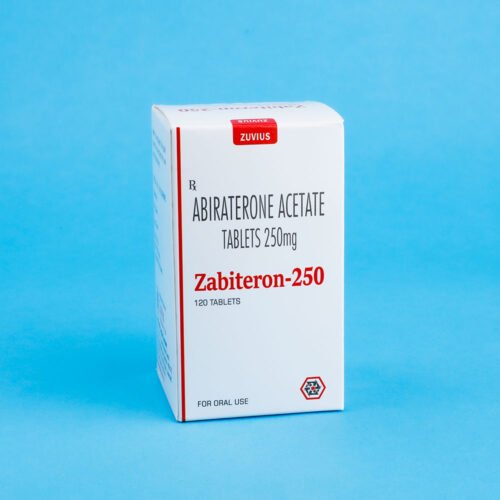Zuvidox
Doxorubicin
Strength: 10mg / 50mg
Pack Size: 1 vial
Drug Class: Anthracyclines and related substances
Dosage and Administration:
The most commonly used dosage schedule is 60-70 mg/m2 as a single intravenous administered at 21 days interval. Lower dose may be required in patients with inadequate marrow reserves.
An alternative dosage schedule of 20 mg /m2 weekly has been reported to produce a lower incidence of congestive heart failure. Doxorubicin dosage should be reduced if the bilirubin is elevated as follow; serum bilirubin 1.3 to 3.0 mg/dl give ½ normal dose, bilirubin > 3.0 mg/dl give 1/4 normal dose .
Reconstitution: Zuvidox 10 and 50 vials should be reconstituted with 5 mL and 25 mL.respectively, of Sodium Chloride Injection, USP /IP (0.9%) to give a final concentration of 2 mg/ML of doxorubicin Hydrochloirde. Bacteriostatic diluents are not recommended. After adding the diluent, the vial should be shaken and the contents allowed to dissolve. The reconstituted solution is stable for 7 days at room temperature and under normal room light and 15 days under refrigeration 2°-8°C( 36°-46°F). It should be protected from exposure to sunlight and any unused solution should be discarded.
Cold Storage: no
Doxorubicin is a cytotoxic anthracycline antibiotic isolated from cultures of Streptomyces peucetius var. Caesisus. Doxorubicin consists of a naphthacenequinone nucleus linked through a glycosidic bond at ringatom 7 to an amino sugar, daunosamine. Chemically, doxorubicin hydrochloride is : (8S, 10S)-10-[(3-Amino2,3,6-trideoxy-a-L-lyxo-hexopyranosyl)-oxy]-8-glycology]-7,8,9,10-tetrahydro-6,8,11-trihydroxy-1-methoxy5,12-naphthacenedione hydrochloride [25316-40-9]
The structural formula is as follows:
Doxorubicin is indicated in the treatment of acute leukemia, soft tissue and bone sarcomas, breast cancer, overian cancer, Hodgkin;s and non Hodgkin’s lymphomas, small cell lung cancer, gastric carcinoma and bladder carcinoma.
Doxorubicin was encapsulated in canine erythrocytes, treated with 0.32% glutaraldehyde, and administered at a dosage equivalent to 30 mg of free doxorubicin/m2 of body surface area to dogs with diagnosis of lymphosarcoma. Compared with administration of free doxorubicin, this method of drug delivery substantially reduced peak plasma concentration and prolonged higher plasma concentration of doxorubicin. As such, this method was comparable to continuous IV infusion. Previous studies have indicated this method’s potential for reduction in toxic side effects, particularly cardiotoxicosis, while allowing higher total doses of doxorubicin to be administered. In this study, doxorubicin encapsulated in glutaraldehyde-treated erythrocytes induced a triphasic exponential decay of doxorubicin from plasma, the highest relative contribution to the total area of the curve being the terminal phase. The treatment was effective in inducing complete and partial remissions of lymphosarcoma, with minimal acute toxicosis and no evidence of cardiotoxicosis. However, substantial, unanticipated, chronic, nonregenerative myelosuppression developed, and was mot strikingly expressed as profound thrombocytopenia. Efforts to ameliorate or circumvent this toxic effect will be required prior to further consideration of this doxorubicin delivery system for treatment of systemic neoplasia.
Special attention must be given to the cardiac toxicity exhibited by doxorubicin, Although uncommon, acute left ventricular failure has occurred particularly in patients who have received a total dosage of the drug exceeding the currently recommended limit of 550 g/m’. The limit appears to be lower in patients who received radiotherapy to the mediastinal area or concomitant therapy with other potentially cardiotoxic agents such as cyclophosphamide. The total dose of doxorubicin administered to the individual patients should also take into account. Previous or concomitant therapy with related compounds such as daunorubicin. Congestive heart failure and/or cardiomyopathy may be encountered several weeks after discontinuation of doxorubicin therapy. Cardiac failure is often not favorably affected by presently known medical or physical therapy for cardiac support. Early Clinical diagnosis of drug-induced heart failure appears to be
essential for successful treatment with digitals. Diuretics, low salt diet, and bed rest. Severe cardiac toxicity may occur precipitously without antecedent ECG changes, A baseline ECG and ECGs performed prior to each dose or course after a 300 mg/m cumulative dose has been given is suggested. Transient ECG changes consisting of T-wave flattering ST depression and arrhythmias lasting up to two weeks after a dose or course of doxorubicin are presently not considered indications for suspension of doxorubicin therapy. Doxorubicin cardiomyopathy has been reported to be associated with a persistent reduction in the voltage of the ORS wave a prolongation of the systolic time interval and a reduction of the ejection fraction as determined by echocardiography or radionuclide angiography None of these tests have yet been confirmed to consistent identity those individual patients that are approaching their maximally tolerated cumulative dose of doxorubicin. If test results indicate a change in cardiac function associated with doxorubicin the benefit of continued therapy must be carefully evaluated against the risk of producing irreversible cardiac damage. Acute life-threatening arrhythmias have been reported to occur during or within a few hours after doxorubicin administration
There is a high incidence of bone marrow depression, primarily of
leukocytes, requiring careful hematologic monitoring with the
recommended dose schedule, leukopenia is usually transient, reaching its
nadir at 10-14 days after treatment with recovery usually occurring by the
21st day
-White blood cell counts as low as 1,000/mm’ are to be expected during
treatment with appropriate doses of doxorubicin. Red blood cell and platelet
levels should also be monitored since they may also be depressed
Hematologic toxicity may require dose reduction or suspension or delay of
doxorubicin therapy. Persistent severe myelosuppression may result in
superinfection or hemorrhage Toxicity to recommended doses of doxorubicin is enhanced by hepatic impairment, therefore prior to the individual dosing evaluation of hepatic function is recommended using conventional clinical laboratory tests, such as SGOT, SGPT, alkaline phosphatase, and bilirubin (See Dosage and Administration) Necrotizing colitis manifested by typhlitis (cecal inflammation bloody stools and severe and sometimes fatal infection have been associated with a combination of doxorubicin given 1.V. Push daily for 3 days and cytarabine given by continuous infusion daily for 7 or more days. On intravenous administration of doxorubicin extravasation, any occur with or without an accompanying stinging or burning sensation and even if blood returns well on aspiration of the infusion needle. If any signs or symptoms and extravasation have occurred the injection or infusion should be immediately terminated and restarted in another vein. Because of the progressive nature of extravasation reactions, the area of injection should be frequently examined and plastic surgery consultation obtained. Early wide exclusion of the involved area should be considered,
Initiate treatment with doxorubicin requires close observation of the patient
and extensive laboratory monitoring. It is recommended, therefore, that patients, be hospitalized at least during the first phase of the treatment like other cytotoxic drugs, doxorubicin may induce hyperuricemia secondary to rapid lysis of neoplastic cells. The clinician should monitor the patient’s blood uric acid level and be prepared to use supportive and pharmacologic measures as might be necessary to control this problem, Doxorubicin imparts coloration to the urine 1-2 days after administration and patients
should be advised to expect this during active therapy
USE DURING PREGNANCY AND LACTATION:
Doxorubicin can cause fetal harm when administered to a pregnant woman
Osorubicin was teratogenic and embryotoxic at doses of 0.8 mg/kg/day
and greater (about 1/13 the recommended human dose on a body surface
basis) when administered during the period of organogenesis in rats
Teratogenicity and embryotoxicity were also seen using discrete periods of
treatment. The most susceptible was the 6 to 9 days gestation period at
doses of 1.25 mg/kg/day and greater Characteristic malformations included
esophageal and intestinal atresia tracheoesophageal feature, hypoplasia of
the urinary bladder, and cardiovascular anomalies, Doxorubicin was
embryotoxic (increase in embryofetal deaths) and abortifacient at 0.4
mg/kg/day (about 1/14 the recommended human dose on a body surface
Tell your doctor right away if you have chest pain, decreased urine output, irregular heartbeat, trouble breathing, rapid weight gain, or swelling of your hands, ankles, or feet. This medicine may increase risk of new cancers, such as acute myelogenous leukemia (AML) or myelodysplastic syndrome (MDS).
















